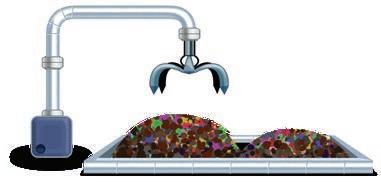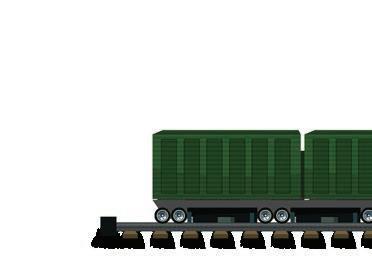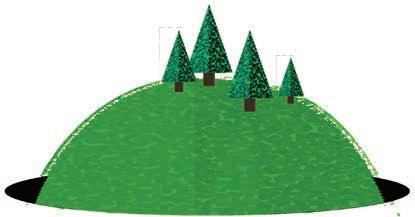
7 minute read
Lane Cove implements new
No time to waste
Lane Cove has partnered with four other councils to structure an environmentally sustainable solution to divert waste away from landfill. By Jocelyn Biddle.
Advertisement
As a member of the Northern Sydney Regional Organisation of Councils (NSROC), Lane Cove has joined together with Hunters Hill, Ku-ring-gai, North Sydney, Ryde and Willoughby councils and entered into a ten-year, $250 million contract that includes converting some mixed household waste into compost.
Veolia, which specialises in water, waste and energy management, is delivering the solution at a purpose-built $100 million waste treatment facility at Woodlawn, near Goulburn. Under the new contract, Veolia will process over 140 thousand tonnes of waste per annum on behalf of the five Northern Sydney councils, together with another six Southern Sydney councils. Lane Cove Council’s General Manager, Craig Wrightson, says that around 42% of general domestic bin waste from Lane Cove is now Craig Wrightson, GM Lane Cove Council being processed to make compost. This compost is then being used to remediate a disused mine site. The remaining waste goes to landfill on the same site.
However, in the next 18 months, the percentage of waste that can be recycled is expected to increase following the introduction of an additional new process that converts the residual waste material unsuitable for composting into a fuel source that could replace fossil fuel in industrial applications.
“When this new stage becomes available, we expect around 83% of our household waste being processed will be transformed into useable materials,” says Wrightson. “This is in addition to Council’s other recycling services that are in place for paper, cardboard, plastic bottles, metals and garden organics.”
Remediating the Woodlawn site
Veolia operate a number of landfill sites around Australia. Their purchase of a disused copper/ lead and zinc mine at Woodlawn required them to rehabilitate
The Waste Alliance Council at Veolia’s site in Woodlawn. L to R: Barry Smith, General Manager, Hunter's Hill Council; Jude Colechin, Senior Coordinator Resource Recovery, Ryde Council; George Dedes, Acting General Manager, Ryde Council; David Roberts, Manager Environment, Willoughby Council; Craig Wrightson, General Manager, Lane Cove Council; and Janine Ricketts, Project Coordinator, Lane Cove Council.
“Around 42% of general domestic bin waste from Lane Cove is now being processed to make compost. In the next 18 months, around 83% our household waste will be transformed into useable materials.” Craig Wrightson, Lane Cove Council
the site, which extends over 6000 hectares.
The compost that is produced from the facility is carefully monitored by the EPA to ensure that it is of the quality required so that the site can be restored back to agricultural land over the course of the next decade.
Councils working with industry to design the best solution
Veolia, it was the local metropolitan councils coming together that provided the volumes necessary for Veolia to develop a viable business case for building the required infrastructure. “Although Australia has plenty of mine sites in need of remediation, a viable business case requires a contracted supply of waste.
“With waste management, different parts of Australia have different drivers. For NSW, a State Government imposed levy of $138/ tonne on top of the cost of landfill has meant that alternative waste treatment options are cost comparable and therefore being actively explored. Other states have either lower or less expensive levies, so the regulatory environment tends to influence the decisions being made.”
Veolia’s new Woodlawn treatment facility has no existing capacity to take waste from additional customers, but does have approvals to expand. With a
Mark Taylor, GM - NSW Resource Recovery, Veolia Aust & NZ
The Waste JourneyThe Waste Journey HOW DOES THE PROCESS WORK? THE WASTE JOURNEY....
DOING YOUR BIT
Collected household waste is taken to Veolia’s Woodlawn eco-precinct by rail and road.

The waste is loaded into a pit where a crane grapple loads the rotating drums.


Waste is combined with air and water in large rotating bio-drums to start degradation and prepare for separation. Inorganic materials and metals are separated for recycling and recovery.
Metals will be recycled


Energy is used to power over 10,000 homes. Waste heat is utilised for onsite aquaculture and horticulture. Any residual waste is transferred to the bioreactor landfill which produces methane gas that is converted into energy and waste heat.
Waste energy for homes

Three months of aerated fermentation and maturation prepares the compost for use in remediation of an old open cut mine.
Back to nature
The organic material is further refined and sent for composting.
reduced landfill capacity and long lead times to build new facilities, it may leave other metropolitan councils with a growing problem.
According to Lane Cove Council’s Craig Wrightson, this is compounded by the fact that there are limited sites available to set up a similar arrangement within reach of Sydney.
“Woodlawn is well-suited for waste transfer by train because it is located close to a rail line. This is a huge advantage, as otherwise you need to rely on transporting the waste by truck, creating hundreds of movements each week.”
Keeping rubbish away from landfill
Veolia’s Taylor says that the Woodlawn facility will divert up to 800,000 tonnes of waste from landfill over the next ten years, saving millions of dollars in waste levy charges.
Following the recent closure of the landfill site at Eastern Creek, there are now only two putrescible landfill sites servicing the Sydney metropolitan area - Lucas Heights, which has capacity for 850 thousand tonnes per year, and Woodlawn, which can process 1.1 million tonnes per year.
Statistics produced by the Environmental Protection Authority say that by 2021, the increased population within NSW will result in
To learn more about the Woodlawn site visit veolia.com/anz/woodlawn or get in touch with our team via email at woodlawn@veolia.com Council Logo nearly 20 million tonnes of waste that needs to be processed. For Sydney alone, another three mixed waste treatment facilities will be required to process a projected 558 thousand tonne surplus by 2021, which will otherwise end up in landfill.
The economics of waste management
Although the environmental benefits can’t be argued, Lane Cove Council’s Craig Wrightson says that the new arrangement is currently more expensive than landfill – but only for the time being.
“The combination of Sydney’s population continuing to increase, landfill sites filling up, and no new facilities coming on stream, will lead to increased demand for waste management services. On this basis, we are hedging that landfill will become a more expensive option in the future, particularly with any increase in waste levy charges.”
Certainly, the positive environmental and economic outcomes that will be achieved with this new venture is a great example of the leverage and efficiencies that occur when local councils work together to address an issue, then seek to develop a solution with industry.
All waste from general Keep your household household bins (which have either bin organic a red or dark green lid) is collected “The waste that people from Lane Cove households and transported by truck to a transfer facility at Banksmeadow each week. The waste is tipped and place in their general garbage is important to the process,” says Veolia’s GM Mark Taylor. “Organic compacted into containers and material is required in order then sent by train to Veolia’s to create the compost that is Woodlawn facility. being used to remediate the
Waste is then combined with mine site. air and water in large, rotating “However, our biggest bio-drums to degrade and prepare challenge is that people use for separation. Through the their general household general sorting process, recyclable bin for items that should materials such as glass, plastics, either be recycled or can metals and textiles that have been be disposed of via general placed into household waste bins Council pick-ups. are separated from the organic “Household waste bins waste and transferred to landfill. generally contain over 60%
In 2017-18 alone, 33,000 tonnes organic material - essentially of waste from the Northern what comes out of your Sydney Councils alliance will be kitchen. If people add processed into compost at the large, bulky or hazardous Woodlawn site. This is in addition items such as batteries to the 80,000 tonnes of waste or household chemicals that is expected to be recycled into these bins, it causes through other programs such as problems in our process. For container and paper recycling. example, batteries contain heavy metals – this can impact the compost that is being made, which affects us meeting EPA standards.” Separate recyclables into yellow and blue bins Your blue bin is for paper products only. Your yellow bin is for plastics and glass. And your large green bin is for garden waste. In a bid to ensure that residents are recycling correctly, and so that unlawful materials such as building waste are not put in residential bins, cameras are installed into rubbish trucks so that the driver can monitor the contents of each bin while it is being loaded. Contaminated loads are either not collected, or households will be reported and potential fines can be imposed.





